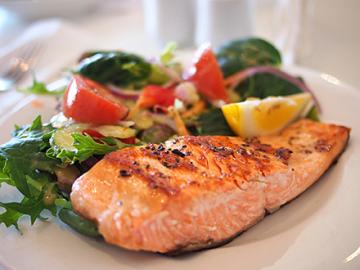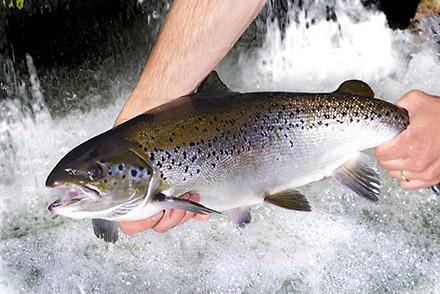From (Fish) Farm to Table: Fish Tech Gets Fancy on the Way to Your Plate

When you order salmon at a restaurant or buy it at the store, what’s the first thing you look at? Price? Nutritional information? Color?
ARS researchers are looking at all of those subjects and more as they partner with the commercial aquaculture industry to produce the salmon of the future. Historically, producers who raise fish, and the researchers who help them, have been most concerned with yield – that is, how much fish can be raised, and how quickly. The goal has been to breed fish that grow as large as possible, as fast as possible. More recently, though, that agenda has expanded as consumers and producers have begun paying attention to a host of additional issues, from sustainability to aesthetics.
One issue that’s been front and center is disease resistance. Raising large fish quickly doesn’t help producers – or consumers – if the fish are weakened or killed by sea lice, a widespread parasite that latches onto the fish in the open net pens in the ocean where most commercially-farmed salmon are raised. To combat the issue, scientists are subtly shifting the emphasis in their breeding programs. According to Brian Peterson, research leader for the USDA-ARS National Cold Water Marine Aquaculture Center in Franklin, ME, the research emphasis is now about 70% growth/30% sea lice resistance.
It’s a complicated equation, because salmon breeding is a relatively long process – the fish take approximately 4 years to reach reproductive maturity. Researchers have to painstakingly record the family lineages of each fish, and spawn those with the most promising traits. Today, they are beginning to complement this technique with the use of genetic markers, a process of tracking specific pieces of the genetic code correlated with different traits of interest. Rather than matching fish to other related fish to measure the inheritance of various traits, they can simply examine the genome of an individual fish to see whether it possesses the markers for desired traits.

Many consumers value the nutritional benefits of salmon, which include a high concentration of heart-healthy omega-3 fatty acids. (Photo by Cattalin)
As technology has improved, commercial aquaculture industry partners have begun to ask ARS researchers about more features they’d like to see in salmon. One major reason consumers like salmon is its health benefits, in particular the presence of omega-3 fatty acids, which contribute to heart health. Omega-3 compounds are only available in a limited number of foods (flax seeds are one of the other main sources), and salmon are known for being an especially rich source, even among fish. Can salmon be bred for higher levels of omega-3? ARS scientists are now beginning to examine that question, too.
Of course, nutrition is not the final consideration when consumers make food choices. Many people believe the color of fish is an indicator of quality. While this is not strictly true, it has become an important enough factor in consumer preference that producers are inquiring about ways to give farmed salmon more of the reddish-pink flesh color that is familiar from their wild cousins. In nature, the coloring results from astaxanthin, a compound that is found in the small crustaceans and other fish that, along with algae, form the salmon’s diet. In farmed settings, scientists are exploring whether astaxanthin might make its way into the salmon diet in another way: Peterson explained that one of USDA’s partner companies has “a species of algae they think will specifically grow astaxanthin. Could we use that?”
Changing the salmon’s diet in some way seems imperative, in any case. Discussing the current feed, Peterson said it is one of the greatest research challenges. “Demands for fish meal and fish oil significantly exceed levels supplied from capture fisheries, so what are some of the alternatives that we can use? Can you replace fish meal with algal meals? Assuming you could optimize the growing conditions, you could grow algae in very large quantities.” Research on an alternative feed developed by industry is representative of the close relationship that ARS has with commercial partners as it works to improve the fish that are raised in the U.S.
The overall goal is to build a more robust domestic supply of farmed salmon, as many consumers do not realize that the fish on their plate – or the brood stock (a supply of parent animals kept for breeding) from which it came – may have come from Norway, Chile, or elsewhere abroad. However, Peterson concluded, “If you live on the east coast, there’s a good chance the fish that you’re eating came from our genetics that we produced here in Franklin.” With many lines of inquiry underway, ARS is well-positioned to help U.S. producers haul in an ever-larger share of the domestic salmon market.– by Kathryn Markham, ARS Office of Communications.
Also in the Summer Seafood Specials series:


